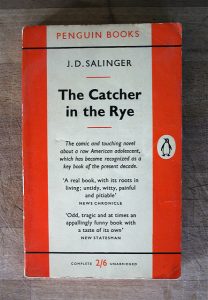1.3.11: Drawing Conclusions, Synthesizing, and Reflecting
- Page ID
- 6125

Figure \(\PageIndex{1}\) - J.D. Salinger’s Catcher in the Rye photo by Andy Field is licensed under CC BY-NC-SA 2.0
Synthesizing
To synthesize is to combine ideas and create a completely new idea. That new idea becomes the conclusion you have drawn from your reading. This is the true beauty of reading: it causes us to weigh ideas, to compare, judge, think, and explore—and then to arrive at a moment that we hadn’t known before. We begin with simple summary, work through analysis, evaluate using critique, and then move on to synthesis.
For example, many people read J.D. Salinger’s The Catcher in the Rye at some point during their lives, often during high school. The book focuses on an angsty, rebellious teen who relates aspects of his teenage experiences, and he does this from his room in a mental institution. In the end, the teen understands more about himself and the world, and he begins to consider his possible future.
Many teens read this story and see themselves in it; grappling with the ideas in the text helps them better understand themselves and often encourages them to reach for their own futures. This is an example of how they draw their own conclusions from the text and synthesize their own directions and ideas.
Most of us can point to one or two books that have been life-changing—books that have held us captive for a moment in time and shaped our outlook. These are moments of synthesis. If this hasn’t happened to you yet, grab a good book (ask a teacher or librarian if you need suggestions), pour a cup of tea, and start reading.
Reflecting
After a period of critical reading, it’s time to reflect. Go back to the earlier discussion in the “Reflect” section (see “Building Strong Reading Skills” in the table on contents). Make some spontaneous notes, write in a writing journal, create a minute paper, or in some way write a few words that capture your experience.


